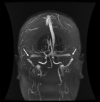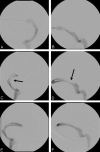Unilateral transverse sinus stenting of patients with idiopathic intracranial hypertension
- PMID: 19942702
- PMCID: PMC7964205
- DOI: 10.3174/ajnr.A1890
Unilateral transverse sinus stenting of patients with idiopathic intracranial hypertension
Abstract
Background and purpose: The pathophysiology of IIH remains unknown. TS stenoses have been observed in a high proportion of these patients. Stent placement to remove this potential obstruction to venous outflow has been proposed as a treatment option for patients with IIH refractory to medical treatment.
Materials and methods: The clinical presentation, treatment, and outcome of patients with refractory IIH evaluated for venous sinus stent placement at a tertiary care center was retrospectively reviewed.
Results: Thirteen female patients with IIH were evaluated for sinovenous stent placement. Moderate sinus stenoses with normal intrasinus pressures were found in 3 patients and therefore stent placement was not performed. Ten patients had elevated intrasinus pressures (pressure gradient across stenosis, 11-50 mm Hg), which decreased following unilateral TS stent placement. Headaches improved or resolved in all stented patients. Papilledema resolved completely or almost completely in 8 patients and significantly improved in 2 patients. One patient developed optic atrophy. There were no major periprocedural complications.
Conclusions: In this small case series, restoring the patency of stenotic venous sinuses with a stent in patients with refractory IIH resulted in symptomatic improvement in all treated patients. The safety and efficacy of this procedure should be evaluated in a randomized controlled study to determine its role within the armamentarium of therapeutic options for patients with IIH.
Figures



References
-
- Acheson JF. Idiopathic intracranial hypertension and visual function. British Med Bull 2006; 79: 233–44 - PubMed
-
- Ball AK, Clarke CE. Idiopathic intracranial hypertension. Lancet Neurol 2006; 5: 433–42 - PubMed
-
- Friedman DI. Pseudotumor cerebri. Neurol Clin N Am 2004; 22: 99–131 - PubMed
-
- Digre KB, Corbett JJ. Idiopathic intracranial hypertension: a reappraisal. Neurologist 2001; 7: 2–67
-
- Corbett JJ, Savino PJ, Thompson HS. Visual loss in pseudotumor cerebri: follow-up of 57 patients from five to 41 years and a profile of 14 patients with permanent severe visual loss. Arch Neurol 1982; 39: 461–74 - PubMed
MeSH terms
LinkOut - more resources
Full Text Sources
Other Literature Sources
